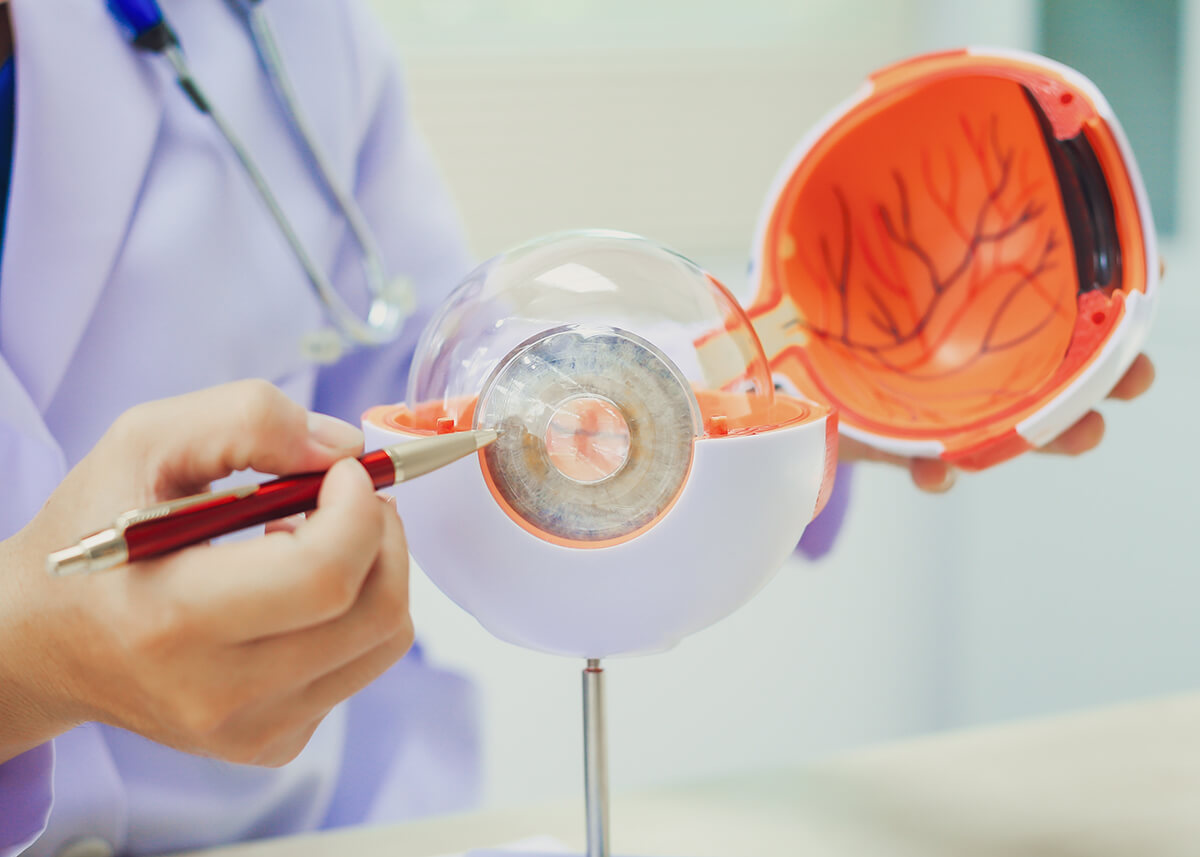What Are Cataracts?
Cataracts develop when the natural lens inside your eye gradually becomes cloudy and less
flexible. This clouding occurs as proteins in the lens break down and clump together over time, blocking
light from passing clearly through to the retina.
While cataracts are most commonly associated with aging, affecting many people after the age
of 65, they can also develop earlier in life due to factors such as diabetes, smoking, certain medications,
or eye injuries. Some people are even born with cataracts or develop them in childhood.
Cataracts can cause numerous symptoms and significantly impact your vision and quality of
life once they mature. The encouraging news is that cataracts are treatable.
Cataract surgery is one of the safest and most successful procedures in all of medicine.
During the procedure, your clouded natural lens is gently removed and replaced with a clear, artificial
intraocular lens (IOL) that can restore sharp vision and, in many cases, reduce your dependence on visual
aids.

How Do You Know If You Have Cataracts?
The best way to determine whether or not you might have cataracts is to visit your eye doctor at Center for Sight for a complete evaluation. During this appointment, your eye doctor will conduct various tests to determine if your symptoms are caused by cataracts. Common symptoms of cataracts include:
If you're experiencing any of these symptoms, don't wait. Early detection and treatment can help preserve your quality of life and prevent cataracts from significantly impacting your daily activities.
No Stitch Cataract Surgery
At Center for Sight, we utilize advanced small-incision cataract surgery techniques that eliminate the need for stitches, providing our patients with a more comfortable and convenient surgical experience. This advanced approach uses ultrasound technology called phacoemulsification to gently break up and remove your cloudy lens through a tiny incision that's smaller than the tip of a pen.
During the procedure, your surgeon creates a precise, self-sealing micro-incision in the cornea. Advanced ultrasound energy is then used to carefully break apart the clouded lens into tiny fragments, which are gently removed from your eye. Once the cataract is completely removed, a clear, artificial intraocular lens (IOL) is inserted through the same small opening and positioned where your natural lens once rested.
Request Appointment

Benefits of
No-Stitch Cataract Surgery
Rapid recovery - Most patients return to normal activities within 24 hours with few restrictions
Enhanced comfort - Little to no discomfort during recovery
Faster visual improvement - Many patients notice clearer vision within hours of the procedure
Reduced astigmatism - The precise incision technique minimizes surgically induced astigmatism
Convenient outpatient procedure - Performed safely at our surgical center with no overnight stay required
Natural healing - The micro-incision seals itself without the need for stitches
Request AppointmentAdvanced Lens Options at Center for Sight
One of the most exciting aspects of modern cataract surgery is the opportunity to not just restore your vision, but potentially improve it beyond what you experienced before cataracts developed. At the Center for Sight, we offer a wide selection of premium intraocular lens (IOL) implants, each designed to address different vision needs and lifestyle preferences.
Standard Monofocal Lens Implants
These high-quality lenses provide excellent vision clarity at one distance. Most people who choose a monofocal lens choose to have their vision corrected for clear distance viewing. While you may still need reading glasses for certain tasks at near, monofocal lenses offer reliable, consistent vision that many patients find ideal for activities like driving, watching television, and enjoying outdoor activities.
Toric Lens Implants
Toric lenses are designed for patients with astigmatism. These lenses combine the benefits of cataract removal with astigmatism correction in a single procedure. These advanced lenses can significantly reduce or eliminate the blurred, distorted vision caused by astigmatism.
Multifocal Lens Implants
Multifocal lenses are designed to provide clear vision at multiple distances, including near, intermediate, and far, potentially freeing you from dependence on glasses for most daily activities. Multifocal IOLs use advanced optical technology to split light into different focal points, allowing you to read, use a computer, and see distant objects with greater independence from visual aids.
During your consultation, your eye doctor will thoroughly evaluate your individual vision needs, lifestyle requirements, and eye health to help you select the IOL option that's perfectly suited for your unique situation. Together, you'll create a personalized treatment plan designed to optimize your vision and enhance your quality of life.
Request AppointmentFrequently Asked Questions About Cataract Surgery
No, cataracts cannot return once they have been surgically removed. However, about 20% of patients may experience cloudy vision months or years later due to the thin membrane behind the lens becoming cloudy. This is easily treated with a quick, painless YAG laser procedure in our office that immediately restores clear vision. You can resume all activities, including driving, immediately after this five-minute treatment.
Before your surgery, arrange for someone to drive you to and from the surgical center, as you won't be able to drive immediately after the procedure. Take your regular medications as prescribed unless specifically instructed otherwise by the surgical team. Avoid wearing makeup, perfume, or cologne on the day of surgery, and wear comfortable, loose-fitting clothing. Our staff will provide you with detailed pre-operative instructions during your consultation to ensure you're fully prepared.
Most patients can resume many of their normal daily activities within 24 hours of surgery, including light work and reading. You should avoid heavy lifting, strenuous exercise, and swimming for about one week. Driving is typically allowed once your eye doctor confirms your vision meets safety requirements during your follow-up appointment.
This depends on the type of intraocular lens you choose. Standard monofocal lenses provide excellent distance vision but typically require reading glasses for close work. Multifocal lenses can reduce or eliminate your dependence on glasses for most activities. Your eye doctor will discuss your lifestyle needs and help you select the best lens option for your goals.

